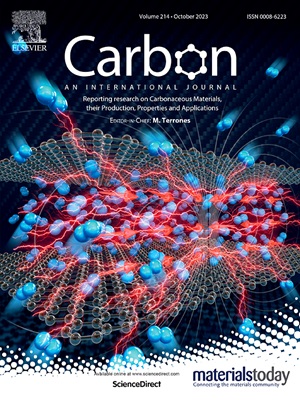Unveiling electronic effects of Brønsted acid substituents in AlCl3-based superacids: Key role in pitch-based mesophase development
IF 10.5
2区 材料科学
Q1 CHEMISTRY, PHYSICAL
引用次数: 0
Abstract
The Lewis acid-catalyzed pyrolysis is crucial for producing mesophase pitch with high aromaticity and superior molecular orientation. While AlCl3 has long been employed as a catalyst in mesophase pitch synthesis, previous studies have largely overlooked the essential role of Brønsted acids in forming Lewis-Brønsted superacid systems that provide the active catalytic centers. To fully activate the catalytic potential of AlCl3, this study focuses on the impact of the electronic effects of various Brønsted acid (alcohols, water, carboxylic acids, and amides) substituents on catalytic performance. The characterization results demonstrate that Brønsted acids with strong electron-withdrawing groups and conjugated structures significantly enhance the catalytic performance, with cyanoacetic acid identified as the optimal candidate. Kinetic analysis reveals that cyanoacetic acid reduces the reaction activation energy by up to 6 kJ/mol compared to other Brønsted acids. The observed trends in activation energy and mesophase sphere size evolution align well with the electronic nature of Brønsted acid substituents. Furthermore, the superacid ratio critically determines mesophase morphology and carbonized sample properties. Insufficient Brønsted acid reduces active centers and polymerization rates, while excess acid increases counterion concentration, accelerating termination and suppressing polymerization. The bulk-type texture mesophase with 96.91 % anisotropic content was prepared only at the optimal cyanoacetic acid addition of 40 mol%. This study establishes a clear structure-activity relationship between Brønsted acid substituents and superacid catalytic efficiency, providing a rational approach for catalyst selection and optimization in mesophase pitch preparation.
揭示基于alcl3的超强酸中Brønsted酸取代基的电子效应:沥青基中间相发展的关键作用
刘易斯酸催化热解是制备具有高芳香性和优越分子取向的中间相沥青的关键。虽然AlCl3一直被用作中间相沥青合成的催化剂,但之前的研究在很大程度上忽视了Brønsted酸在形成提供活性催化中心的Lewis-Brønsted超强酸体系中的重要作用。为了充分激活AlCl3的催化潜力,本研究重点研究了各种Brønsted酸(醇、水、羧酸和酰胺)取代基的电子效应对催化性能的影响。表征结果表明,具有强吸电子基团和共轭结构的Brønsted酸显著提高了催化性能,氰乙酸被确定为最佳候选。动力学分析表明,与其他Brønsted酸相比,氰乙酸可使反应活化能降低6 kJ/mol。所观察到的活化能和中间相球体大小的变化趋势与br / nsted酸取代基的电子性质一致。此外,超酸比对中间相形态和碳化样品的性质有重要影响。Brønsted酸不足会降低活性中心和聚合速率,而过量的酸会增加反离子浓度,加速终止并抑制聚合。在最佳氰乙酸添加量为40 mol%时,制得各向异性含量为96.91%的体型织构中间相。本研究建立了Brønsted酸取代基与超强酸催化效率之间清晰的构效关系,为中间相沥青制备中催化剂的选择和优化提供了合理的思路。
本文章由计算机程序翻译,如有差异,请以英文原文为准。
求助全文
约1分钟内获得全文
求助全文
来源期刊

Carbon
工程技术-材料科学:综合
CiteScore
20.80
自引率
7.30%
发文量
0
审稿时长
23 days
期刊介绍:
The journal Carbon is an international multidisciplinary forum for communicating scientific advances in the field of carbon materials. It reports new findings related to the formation, structure, properties, behaviors, and technological applications of carbons. Carbons are a broad class of ordered or disordered solid phases composed primarily of elemental carbon, including but not limited to carbon black, carbon fibers and filaments, carbon nanotubes, diamond and diamond-like carbon, fullerenes, glassy carbon, graphite, graphene, graphene-oxide, porous carbons, pyrolytic carbon, and other sp2 and non-sp2 hybridized carbon systems. Carbon is the companion title to the open access journal Carbon Trends. Relevant application areas for carbon materials include biology and medicine, catalysis, electronic, optoelectronic, spintronic, high-frequency, and photonic devices, energy storage and conversion systems, environmental applications and water treatment, smart materials and systems, and structural and thermal applications.
 求助内容:
求助内容: 应助结果提醒方式:
应助结果提醒方式:


